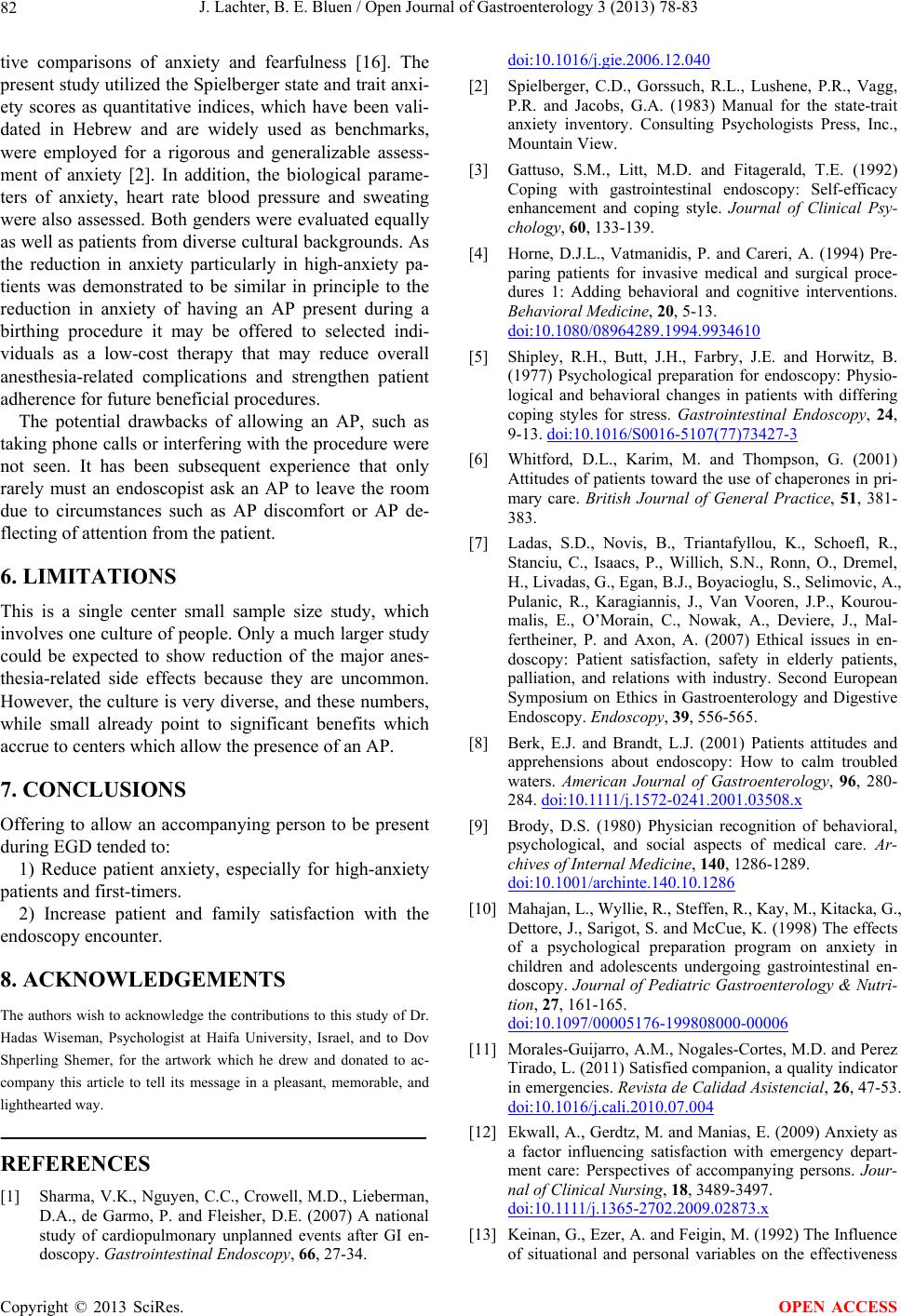
J. Lachter, B. E. Bluen / Open Journal of Gastroenterology 3 (2013) 78-83
82
tive comparisons of anxiety and fearfulness [16]. The
present study utilized th e Spielberger state and trait anxi-
ety scores as quantitative indices, which have been vali-
dated in Hebrew and are widely used as benchmarks,
were employed for a rigorous and generalizable assess-
ment of anxiety [2]. In addition, the biological parame-
ters of anxiety, heart rate blood pressure and sweating
were also assessed. Both genders were evaluated equally
as well as patients from diverse cultural backgrounds. As
the reduction in anxiety particularly in high-anxiety pa-
tients was demonstrated to be similar in principle to the
reduction in anxiety of having an AP present during a
birthing procedure it may be offered to selected indi-
viduals as a low-cost therapy that may reduce overall
anesthesia-related complications and strengthen patient
adherence for future beneficial procedures.
The potential drawbacks of allowing an AP, such as
taking phone calls or interfering with the procedure were
not seen. It has been subsequent experience that only
rarely must an endoscopist ask an AP to leave the room
due to circumstances such as AP discomfort or AP de-
flecting of attention from the patient.
6. LIMITATIONS
This is a single center small sample size study, which
involves one cu lture of people. Only a much larger stud y
could be expected to show reduction of the major anes-
thesia-related side effects because they are uncommon.
However, the culture is very diverse, and these numbers,
while small already point to significant benefits which
accrue to centers which allow the presence of an AP.
7. CONCLUSIONS
Offering to allow an accompanying person to be present
during EGD tended to:
1) Reduce patient anxiety, especially for high-anxiety
patients and first-timers.
2) Increase patient and family satisfaction with the
endoscopy encounter.
8. ACKNOWLEDGEMENTS
The authors wish to acknowledge the contributions to this study of Dr.
Hadas Wiseman, Psychologist at Haifa University, Israel, and to Dov
Shperling Shemer, for the artwork which he drew and donated to ac-
company this article to tell its message in a pleasant, memorable, and
lighthearted way.
REFERENCES
[1] Sharma, V.K., Nguy en, C.C., Crowell, M.D., Lieberman,
D.A., de Garmo, P. and Fleisher, D.E. (2007) A national
study of cardiopulmonary unplanned events after GI en-
doscopy. Gastrointestinal Endosc op y, 66, 27-34.
doi:10.1016/j.gie.2006.12.040
[2] Spielberger, C.D., Gorssuch, R.L., Lushene, P.R., Vagg,
P.R. and Jacobs, G.A. (1983) Manual for the state-trait
anxiety inventory. Consulting Psychologists Press, Inc.,
Mountain View.
[3] Gattuso, S.M., Litt, M.D. and Fitagerald, T.E. (1992)
Coping with gastrointestinal endoscopy: Self-efficacy
enhancement and coping style. Journal of Clinical Psy-
chology, 60, 133-139.
[4] Horne, D.J.L., Vatmanidis, P. and Careri, A. (1994) Pre-
paring patients for invasive medical and surgical proce-
dures 1: Adding behavioral and cognitive interventions.
Behavioral Medicine, 20, 5-13.
doi:10.1080/08964289.1994.9934610
[5] Shipley, R.H., Butt, J.H., Farbry, J.E. and Horwitz, B.
(1977) Psychological preparation for endoscopy: Physio-
logical and behavioral changes in patients with differing
coping styles for stress. Gastrointestinal Endoscopy, 24,
9-13. doi:10.1016/S0016-5107(77)73427-3
[6] Whitford, D.L., Karim, M. and Thompson, G. (2001)
Attitudes of patients toward the use of chaperones in pri-
mary care. British Journal of General Practice, 51, 381-
383.
[7] Ladas, S.D., Novis, B., Triantafyllou, K., Schoefl, R.,
Stanciu, C., Isaacs, P., Willich, S.N., Ronn, O., Dremel,
H., Livadas, G. , Egan, B. J., Boyaci oglu, S., Se limovic, A.,
Pulanic, R., Karagiannis, J., Van Vooren, J.P., Kourou-
malis, E., O’Morain, C., Nowak, A., Deviere, J., Mal-
fertheiner, P. and Axon, A. (2007) Ethical issues in en-
doscopy: Patient satisfaction, safety in elderly patients,
palliation, and relations with industry. Second European
Symposium on Ethics in Gastroenterology and Digestive
Endoscopy. Endoscopy, 39, 556-565.
[8] Berk, E.J. and Brandt, L.J. (2001) Patients attitudes and
apprehensions about endoscopy: How to calm troubled
waters. American Journal of Gastroenterology, 96, 280-
284. doi:10.1111/j.1572-0241.2001.03508.x
[9] Brody, D.S. (1980) Physician recognition of behavioral,
psychological, and social aspects of medical care. Ar-
chives of Internal Medicine, 140, 1286-1289.
doi:10.1001/archinte.140.10.1286
[10] Mahajan, L., Wyllie, R., Steffen, R., Kay, M., Kitacka, G.,
Dettore, J., Sarigot, S. and McCue, K. (1998) The effects
of a psychological preparation program on anxiety in
children and adolescents undergoing gastrointestinal en-
doscopy. Journal of Pediatric Gastroenterology & Nutri-
tion, 27, 161-165.
doi:10.1097/00005176-199808000-00006
[11] Morales-Guijarro, A.M., Nogales-Cortes, M.D. and Perez
Tirado, L. (2011) Satisfied companion, a quality indicator
in emergencies. Revista de Calidad Asistencial, 26, 47-53.
doi:10.1016/j.cali.2010.07.004
[12] Ekwall, A., Gerdtz, M. and Manias, E. (2009) Anxiety as
a factor influencing satisfaction with emergency depart-
ment care: Perspectives of accompanying persons. Jour-
nal of Clinical Nursing, 18, 3489-3497.
doi:10.1111/j.13 65-2702.2009.02873.x
[13] Keinan, G., Ezer, A. and Feigin, M. (1992) The Influence
of situational and personal variables on the effectiveness
Copyright © 2013 SciRes. OPEN ACCESS